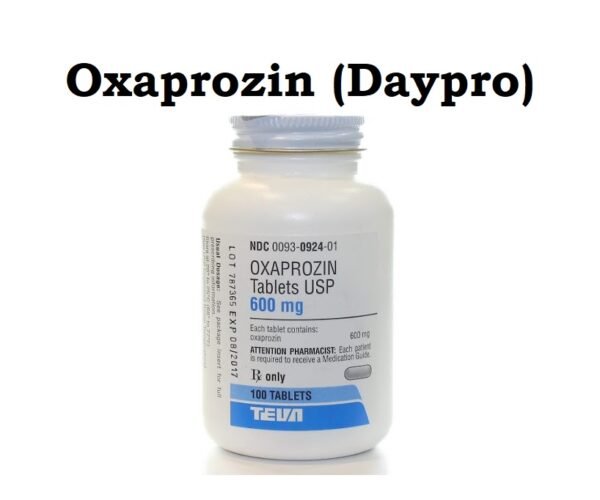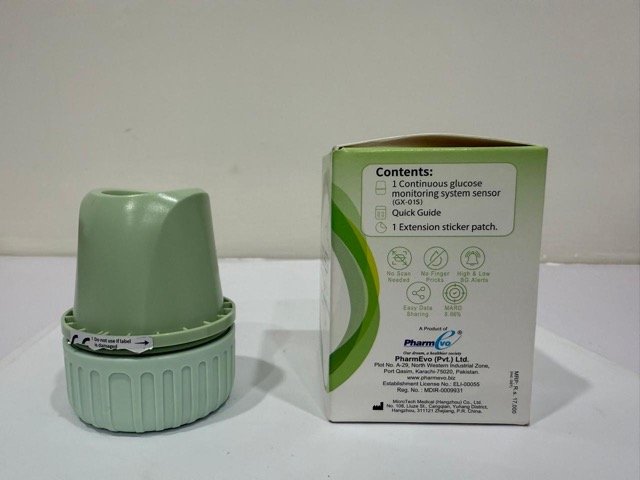Oxaprozin (Daypro) is a non-steroidal anti-inflammatory drug that has analgesic, antipyretic, and anti-inflammatory properties.
Oxaprozin Uses:
-
Juvenile rheumatoid arthritis:
- Used for relief of signs and symptoms of juvenile rheumatoid arthritis (JRA).
-
Osteoarthritis:
- Used for relief of signs and symptoms of osteoarthritis.
-
Rheumatoid arthritis:
- Used for relief of signs and symptoms of rheumatoid arthritis.
Oxaprozin Dose in Adults
Note:
- Individualize dosage to the lowest effective dose for the shortest duration to minimize adverse effects.
Oxaprozin Dose in the treatment of osteoarthritis and rheumatoid arthritis:
Oral:
- 1,200 mg OD.
Note:
- Patients with low body weight should start with 600 mg OD.
- A one-time loading dose of 1,200 to 1,800 mg (≤26 mg/kg) may be used when a quick onset of action is desired.
-
Maximum doses:
- Patient <50 kg:
- Maximum: 1,200 mg daily
- Patient >50 kg with normal renal/hepatic function and low risk of peptic ulcer:
- Maximum: 1,800 mg OD or 26 mg/kg/day (whichever is lower) in divided doses
- Patient <50 kg:
Oxaprozin Dose in Children
Note:
- Use lowest effective dose
- dose may be divided if the patient does not tolerate once-daily dosing.
Oxaprozin Dose in the treatment of Juvenile Idiopathic Arthritis (JIA):
-
Children ≥6 years and Adolescents:
Weight-directed dosing:
- Oral: 10 to 20 mg/kg/dose once a day
- Maximum daily dose: 1,200 mg/day (Miller 1992)
-
Fixed dosing:
-
Oral:
- 22 to 31 kg:
- 600 mg once a day
- 32 to 54 kg:
- 900 mg once a day
- ≥55 kg:
- 1,200 mg once a day
Pregnancy Risk Category: C/ D (in third trimester)
- Some studies have shown that birth defects can be caused by in utero NSAID use. However, the data is inconsistent.
- Following in utero NSAID treatment, nonteratogenic effects such as prenatal constriction, persistent pulmonary hypertension, oligohydramnios and necrotizing enterocolitis have been seen in the fetus/neonate.
- Additionally, postnatal nonclosure of ductus arteriosus may occur. This can be difficult to manage medically.
- Because NSAIDs can cause premature closure of ductus arteriosus, oxaprozin's product label specifically states that oxaprozin should not be used starting at 30 weeks gestation.
- NSAIDs may be used to treat mild rheumatoid-arthritis flares in pregnant women. However, it should be avoided or minimized early in pregnancy.
- Women of reproductive age who have been using NSAIDs for a long time may experience infertility. This can be reversed by stopping the medication.
- Women who have difficulty conceiving or are undergoing fertility treatment should consider quitting.
- Using NSAIDs near to conception could increase the risk of miscarriage.
Oxaprozin use during breastfeeding:
- It is unknown if oxaprozin secreted in breastmilk.
- Postpartum women who want to breastfeed may use NSAIDs.
- Women who breastfeed infants with platelet dysfunction and thrombocytopenia should avoid using any other agents than oxaprozin.
- According to the manufacturer breastfeeding during therapy is a decision that should be made after considering the risks to infants, the benefits to the mother and the benefits to the mother.
Oxaprozin Dose in Kidney Disease:
- In general, NSAIDs are not recommended for use in patients with advanced renal disease but the manufacturer of oxaprozin does provide some guidelines for adjustment in renal dysfunction.
-
Severe renal impairment or on dialysis:
- 600 mg once a day; may increase with caution to 1200 mg/day with close monitoring.
- Not significantly removed by hemodialysis or CAPD.
Oxaprozin Dose in Liver Disease:
- Use cautiously in patients with severe hepatic impairment.
Side Effects of Oxaprozin (Daypro):
-
Cardiovascular:
- Edema
-
Central Nervous System:
- Confusion
- Depression
- Disturbed Sleep
- Dizziness
- Drowsiness
- Headache
- Sedation
-
Dermatologic:
- Pruritus
- Skin Rash
-
Gastrointestinal:
- Abdominal Distress
- Abdominal Pain
- Anorexia
- Constipation
- Diarrhea
- Dyspepsia
- Flatulence
- Gastrointestinal Perforation (With Gross Bleeding)
- Gastrointestinal Ulcer
- Heartburn
- Nausea
- Vomiting
-
Genitourinary:
- Dysuria
- Urinary Frequency
-
Hematologic & Oncologic:
- Anemia
- Prolonged Bleeding Time
-
Hepatic:
- Increased Liver Enzymes
-
Otic:
- Tinnitus
-
Renal:
- Renal Insufficiency
Contraindications to Oxaprozin (Daypro):
- Hypersensitivity to oxaprozin and any component of the formulation
- History of asthma, urticaria or other allergic reactions following aspirin or other NSAIDs. This is when coronary artery bypass graft surgery (CABG), is performed.
Warnings and precautions
-
Anaphylactoid reactions
- Anaphylactoid reactions can occur even in patients who have not been exposed to anaphylactic substances before.
- Patients with the "aspirine triad" (bronchial aspirin intolerance, rhinitis, and asthma) could be at higher risk.
- Patients with bronchospasm or rhinitis or a history of NSAID or aspirin therapy are not recommended to use this medication.
-
Cardiovascular events: [US Boxed Warn]
- The increased risk of severe (and possibly fatal) adverse cardiovascular events due to NSAIDs, such as stroke and MI, can be caused by NSAIDs.
- This risk can occur during treatment, and it may increase as the duration of use is prolonged.
- The relative risk of developing cardiovascular disease or other risk factors is similar for those with and without cardiovascular disease.
- Patients with known cardiovascular disease and risk factors had a higher absolute incidence of cardiovascular events (which can occur earlier during treatment).
- New-onset hypertension or exacerbation of hypertension may occur (NSAIDs may also impair response to ACE inhibitors, thiazide diuretics, or loop diuretics)
- May be associated with cardiovascular events
- Hypertension patients should monitor their blood pressure.
- Patients with edema may experience sodium and fluid retention.
- Patients with heart failure should be avoided
- Patients with MI should not be treated unless the benefits are greater than the risk of developing cardiovascular thrombotic complications.
- To reduce your risk of developing cardiovascular events, use the lowest effective dose for the shortest time. This is consistent with the individual patient's goals.
- For patients with high-risk conditions, consider alternative therapies.
-
CNS effects
- This can cause blurred vision, drowsiness, and dizziness.
- It is important to warn patients about tasks that require mental alertness, such as driving or operating machinery.
- If you have blurred or reduced vision, discontinue using the product and consult an ophthalmologist.
- All patients undergoing long-term therapy should be evaluated periodically for vision.
-
GI events: [US Boxed Warning]
- NSAIDs increase the risk of severe GI inflammation, bleeding, ulceration, and perforation (may prove fatal); patients older than 65 years old and those with a history peptic ulcer disease or GI bleeding are more at risk.
- These events can occur without warning and at any time during therapy.
- Patients with active GI bleeding should be avoided
- Avoid non-aspirin NSAIDs in patients who have had a history or experience of severe lower GI bleeding.
- Be cautious if you have a history of GI problems. Concurrent therapy can increase the risk of GI bleeding.
- To reduce the chance of GI adverse reactions, use the lowest effective dose for the shortest time.
- For patients with high-risk conditions, consider alternative therapies.
- When used concomitantly with aspirin, a substantial increase in the risk of GI complications (eg, ulcer) occurs; concomitant gastroprotective therapy (eg, PPI) is recommended for use.
-
Hematologic effects
- It is possible to decrease platelet adhesion or aggregation
- May prolong bleeding time
- Patients with coagulation problems or those who are taking anticoagulants need to be closely monitored.
- Anemia may occur.
- Anemia should be checked in patients on long-term NSAID therapy.
- Rarely, NSAIDs have been linked to severe blood dyscrasias, such as agranulocytosis or thrombocytopenia.
-
Hyperkalemia:
- NSAIDs can increase hyperkalemia risk, especially in elderly people, diabetics, kidney disease, and concomitant usage of other agents that induce hyperkalemia (eg ACE-inhibitors).
- Potassium should always be closely monitored
-
Photosensitivity reactions
- Mild photosensitivity reactions may occur.
-
Reactions to skin:
- NSAIDs can cause severe skin adverse reactions, including Stevens-Johnson syndrome (SJS), toxic epidermal necrolysis (TEN), and exfoliative dermatology (ES).
- Stop using the medication immediately if you notice skin rash or hypersensitivity.
-
Asthma
- Patients with asthma that is aspirin sensitive should not be treated
- It is possible to experience severe bronchospasm.
- Patients with other forms or asthma should be cautious.
-
Bariatric surgery
- Gastric ulceration: Avoid chronic use of oral nonselective NSAIDs after bariatric surgery; the development of anastomotic ulcerations/perforations may occur.
- As part of a multimodal pain management strategy, celecoxib and intravenous ketorolac are recommended for short-term pain relief.
-
Coronary bypass surgery for coronary artery bypass: [US Boxed Warn]
- Contraindicated for the placement of coronary bypass graft surgery (CABG).
- Use of CABG surgery may increase the risk of stroke and MI.
-
Hepatic impairment
- Patients with reduced hepatic function should be cautious.
- Monitor patients with abnormal LFT closely.
- Rare, sometimes fatal, severe hepatic reactions have been reported with NSAIDs.
- If you experience liver disease symptoms, persistent or worsening abnormal liver function tests, or if there are any other signs or symptoms, discontinue use.
-
Hypertension:
- Be careful, as you may increase your risk of developing hypertension.
-
Renal impairment
- NSAIDs can cause impairment of renal function. Dose-dependent decreases may occur in prostaglandin synthesis due to NSAID usage. This could lead to reduced renal blood flow, which could cause renal decompensation.
- Patients with impaired renal function, hypovolemia and heart failure, patients taking diuretics and ACE inhibitors, angiotensin I receptor blockers, and elderly patients are more at risk for renal toxicity.
- Before starting treatment, hydrate the patient and monitor renal function.
- Patients with advanced renal disease should avoid use. If abnormal or persistent renal function tests are found, discontinue use.
- Long-term NSAID treatment may cause renal papillary necrosis.
Oxaprozin: Drug Interaction
|
Risk Factor C (Monitor therapy) |
|
|
5-Aminosalicylic Acid Derivatives |
Nonsteroidal Anti-Inflammatory Agents may enhance the nephrotoxic effect of 5-Aminosalicylic Acid Derivatives. |
|
Agents with Antiplatelet Properties (e.g., P2Y12 inhibitors, NSAIDs, SSRIs, etc.) |
May enhance the antiplatelet effect of other Agents with Antiplatelet Properties. |
|
Alcohol (Ethyl) |
May enhance the adverse/toxic effect of Nonsteroidal Anti-Inflammatory Agents. Specifically, the risk of GI bleeding may be increased with this combination. |
|
Aliskiren |
Nonsteroidal Anti-Inflammatory Agents may diminish the antihypertensive effect of Aliskiren. Nonsteroidal Anti-Inflammatory Agents may enhance the nephrotoxic effect of Aliskiren. Management: Monitor renal function periodically in patients receiving aliskiren and any nonsteroidal anti-inflammatory agent. Patients at elevated risk of renal dysfunction include those who are elderly, are volume depleted, or have pre-existing renal dysfunction. |
|
Aminoglycosides |
Nonsteroidal Anti-Inflammatory Agents may decrease the excretion of Aminoglycosides. Data only in premature infants. |
|
Aminolevulinic Acid (Topical) |
Photosensitizing Agents may enhance the photosensitizing effect of Aminolevulinic Acid (Topical). |
|
Angiotensin II Receptor Blockers |
May enhance the adverse/toxic effect of Nonsteroidal AntiInflammatory Agents. Specifically, the combination may result in a significant decrease in renal function. Nonsteroidal Anti-Inflammatory Agents may diminish the therapeutic effect of Angiotensin II Receptor Blockers. The combination of these two agents may also significantly decrease glomerular filtration and renal function. |
|
Angiotensin-Converting Enzyme Inhibitors |
May enhance the adverse/toxic effect of Nonsteroidal Anti-Inflammatory Agents. Specifically, the combination may result in a significant decrease in renal function. Nonsteroidal Anti-Inflammatory Agents may diminish the antihypertensive effect of Angiotensin-Converting Enzyme Inhibitors. |
|
Anticoagulants |
Agents with Antiplatelet Properties may enhance the anticoagulant effect of Anticoagulants. Exceptions: Bemiparin; Enoxaparin; Heparin. |
|
Anticoagulants |
Nonsteroidal Anti-Inflammatory Agents may enhance the anticoagulant effect of Anticoagulants. Exceptions: Bemiparin; Enoxaparin; Heparin. |
|
Beta-Blockers |
Nonsteroidal Anti-Inflammatory Agents may diminish the antihypertensive effect of Beta-Blockers. Exceptions: Levobunolol; Metipranolol. |
|
Bisphosphonate Derivatives |
Nonsteroidal Anti-Inflammatory Agents may enhance the adverse/toxic effect of Bisphosphonate Derivatives. Both an increased risk of gastrointestinal ulceration and an increased risk of nephrotoxicity are of concern. |
|
Cephalothin |
Agents with Antiplatelet Properties may enhance the adverse/toxic effect of Cephalothin. Specifically, the risk for bleeding may be increased. |
|
Collagenase (Systemic) |
Agents with Antiplatelet Properties may enhance the adverse/toxic effect of Collagenase (Systemic). Specifically, the risk of injection site bruising and/or bleeding may be increased. |
|
Corticosteroids (Systemic) |
May enhance the adverse/toxic effect of Nonsteroidal AntiInflammatory Agents (Nonselective). |
|
Dasatinib |
May enhance the anticoagulant effect of Agents with Antiplatelet Properties. Management: Drugs listed as exceptions to this monograph are discussed in further detail in separate drug interaction monographs. |
|
Deferasirox |
Nonsteroidal Anti-Inflammatory Agents may enhance the adverse/toxic effect of Deferasirox. Specifically, the risk for GI ulceration/irritation or GI bleeding may be increased. |
|
Deoxycholic Acid |
Agents with Antiplatelet Properties may enhance the adverse/toxic effect of Deoxycholic Acid. Specifically, the risk for bleeding or bruising in the treatment area may be increased. |
|
Desmopressin |
Nonsteroidal Anti-Inflammatory Agents may enhance the adverse/toxic effect of Desmopressin. |
|
Digoxin |
Nonsteroidal Anti-Inflammatory Agents may increase the serum concentration of Digoxin. |
|
Drospirenone |
Nonsteroidal Anti-Inflammatory Agents may enhance the hyperkalemic effect of Drospirenone. |
|
Eplerenone |
Nonsteroidal Anti-Inflammatory Agents may diminish the antihypertensive effect of Eplerenone. Nonsteroidal Anti-Inflammatory Agents may enhance the hyperkalemic effect of Eplerenone. |
|
Fat Emulsion (Fish Oil Based) |
May enhance the adverse/toxic effect of Agents with Antiplatelet Properties. |
|
Felbinac |
May enhance the adverse/toxic effect of Nonsteroidal Anti-Inflammatory Agents. |
|
Glucosamine |
May enhance the antiplatelet effect of Agents with Antiplatelet Properties. |
|
Haloperidol |
Nonsteroidal Anti-Inflammatory Agents may enhance the adverse/toxic effect of Haloperidol. Specifically including drowsiness and confusion. |
|
HydrALAZINE |
Nonsteroidal Anti-Inflammatory Agents may diminish the antihypertensive effect of HydrALAZINE. |
|
Ibritumomab Tiuxetan |
Agents with Antiplatelet Properties may enhance the adverse/toxic effect of Ibritumomab Tiuxetan. Both agents may contribute to impaired platelet function and an increased risk of bleeding. |
|
Ibrutinib |
May enhance the adverse/toxic effect of Agents with Antiplatelet Properties. |
|
Inotersen |
May enhance the antiplatelet effect of Agents with Antiplatelet Properties. |
|
Limaprost |
May enhance the antiplatelet effect of Agents with Antiplatelet Properties. |
|
Multivitamins/Fluoride (with ADE) |
May enhance the antiplatelet effect of Agents with Antiplatelet Properties. |
|
Multivitamins/Minerals (with ADEK, Folate, Iron) |
May enhance the antiplatelet effect of Agents with Antiplatelet Properties. |
|
Multivitamins/Minerals (with AE, No Iron) |
May enhance the antiplatelet effect of Agents with Antiplatelet Properties. |
|
Naftazone |
May enhance the antiplatelet effect of Nonsteroidal Anti-Inflammatory Agents. |
|
Obinutuzumab |
Agents with Antiplatelet Properties may enhance the adverse/toxic effect of Obinutuzumab. Specifically, the risk of serious bleeding-related events may be increased. |
|
Omega-3 Fatty Acids |
May enhance the antiplatelet effect of Agents with Antiplatelet Properties. |
|
Pentosan Polysulfate Sodium |
May enhance the adverse/toxic effect of Agents with Antiplatelet Properties. Specifically, the risk of bleeding may be increased by concurrent use of these agents. |
|
Pentoxifylline |
May enhance the antiplatelet effect of Agents with Antiplatelet Properties. |
|
Porfimer |
Photosensitizing Agents may enhance the photosensitizing effect of Porfimer. |
|
Potassium-Sparing Diuretics |
Nonsteroidal Anti-Inflammatory Agents may diminish the antihypertensive effect of Potassium-Sparing Diuretics. Nonsteroidal Anti-Inflammatory Agents may enhance the hyperkalemic effect of Potassium-Sparing Diuretics. |
|
PRALAtrexate |
Nonsteroidal Anti-Inflammatory Agents may increase the serum concentration of PRALAtrexate. More specifically, NSAIDS may decrease the renal excretion of pralatrexate. Management: Closely monitor for increased pralatrexate serum levels and/or toxicity if used concomitantly with an NSAID. Monitor for decreased pralatrexate serum levels with NSAID discontinuation. |
|
Probenecid |
May increase the serum concentration of Nonsteroidal Anti-Inflammatory Agents. |
|
Prostacyclin Analogues |
May enhance the antiplatelet effect of Agents with Antiplatelet Properties. |
|
Prostaglandins (Ophthalmic) |
Nonsteroidal Anti-Inflammatory Agents may diminish the therapeutic effect of Prostaglandins (Ophthalmic). Nonsteroidal Anti-Inflammatory Agents may also enhance the therapeutic effects of Prostaglandins (Ophthalmic). |
|
Quinolones |
Nonsteroidal Anti-Inflammatory Agents may enhance the neuroexcitatory and/or seizure-potentiating effect of Quinolones. Nonsteroidal Anti-Inflammatory Agents may increase the serum concentration of Quinolones. |
|
Salicylates |
Agents with Antiplatelet Properties may enhance the adverse/toxic effect of Salicylates. Increased risk of bleeding may result. |
|
Serotonin/Norepinephrine Reuptake Inhibitors |
May enhance the antiplatelet effect of Nonsteroidal Anti-Inflammatory Agents (Nonselective). |
|
Tacrolimus (Systemic) |
Nonsteroidal Anti-Inflammatory Agents may enhance the nephrotoxic effect of Tacrolimus (Systemic). |
|
Thiazide and Thiazide-Like Diuretics |
May enhance the nephrotoxic effect of Nonsteroidal AntiInflammatory Agents. Nonsteroidal Anti-Inflammatory Agents may diminish the therapeutic effect of Thiazide and Thiazide-Like Diuretics. |
|
Thrombolytic Agents |
Agents with Antiplatelet Properties may enhance the anticoagulant effect of Thrombolytic Agents. |
|
Tipranavir |
May enhance the antiplatelet effect of Agents with Antiplatelet Properties. |
|
Tolperisone |
Nonsteroidal Anti-Inflammatory Agents may enhance the adverse/toxic effect of Tolperisone. Specifically, the risk of hypersensitivity reactions may be increased. Tolperisone may enhance the therapeutic effect of Nonsteroidal Anti-Inflammatory Agents. |
|
Tricyclic Antidepressants (Tertiary Amine) |
May enhance the antiplatelet effect of Nonsteroidal Anti-Inflammatory Agents (Nonselective). |
|
Vancomycin |
Nonsteroidal Anti-Inflammatory Agents may increase the serum concentration of Vancomycin. |
|
Verteporfin |
Photosensitizing Agents may enhance the photosensitizing effect of Verteporfin. |
|
Vitamin E (Systemic) |
May enhance the antiplatelet effect of Agents with Antiplatelet Properties. |
|
Risk Factor D (Consider therapy modification) |
|
|
Apixaban |
Nonsteroidal Anti-Inflammatory Agents (Nonselective) may enhance the adverse/toxic effect of Apixaban. Specifically, the risk of bleeding may be increased. Management: A comprehensive risk to benefit assessment should be done for all patients before any concurrent use of apixaban and nonsteroidal anti-inflammatory drugs (NSAIDs). If combined, monitor patients extra closely for signs and symptoms of bleeding. |
|
Bemiparin |
Nonsteroidal Anti-Inflammatory Agents may enhance the anticoagulant effect of Bemiparin. Management: Avoid concomitant use of bemiparin and nonsteroidal anti-inflammatory agents (NSAIDs) due to the increased risk of bleeding. If concomitant use is unavoidable, monitor closely for signs and symptoms of bleeding. |
|
Bemiparin |
Agents with Antiplatelet Properties may enhance the anticoagulant effect of Bemiparin. Management: Avoid concomitant use of bemiparin with antiplatelet agents. If concomitant use is unavoidable, monitor closely for signs and symptoms of bleeding. |
|
Bile Acid Sequestrants |
May decrease the absorption of Nonsteroidal Anti-Inflammatory Agents. |
|
CycloSPORINE (Systemic) |
Nonsteroidal Anti-Inflammatory Agents may enhance the nephrotoxic effect of CycloSPORINE (Systemic). Nonsteroidal Anti-Inflammatory Agents may increase the serum concentration of CycloSPORINE (Systemic). CycloSPORINE (Systemic) may increase the serum concentration of Nonsteroidal Anti-Inflammatory Agents. Management: Consider alternatives to nonsteroidal anti-inflammatory agents (NSAIDs). Monitor for evidence of nephrotoxicity, as well as increased serum cyclosporine concentrations and systemic effects (eg, hypertension) during concomitant therapy with NSAIDs. |
|
Dabigatran Etexilate |
Nonsteroidal Anti-Inflammatory Agents (Nonselective) may enhance the adverse/toxic effect of Dabigatran Etexilate. Specifically, the risk of bleeding may be increased. Management: A comprehensive risk to benefit assessment should be done for all patients before any concurrent use of dabigatran and nonsteroidal anti-inflammatory drugs (NSAIDs). If combined, monitor patients extra closely for signs and symptoms of bleeding. |
|
Diclofenac (Systemic) |
May enhance the adverse/toxic effect of Nonsteroidal Anti-Inflammatory Agents. Management: Seek alternatives to the combined use of diclofenac with other nonsteroidal anti-inflammatory agents (NSAIDs). Avoid the use of diclofenac/misoprostol with other NSAIDs. |
|
Edoxaban |
Nonsteroidal Anti-Inflammatory Agents (Nonselective) may enhance the adverse/toxic effect of Edoxaban. Specifically, the risk of bleeding may be increased. Management: A comprehensive risk to benefit assessment should be done for all patients before any concurrent use of edoxaban and nonsteroidal anti-inflammatory drugs (NSAIDs). If combined, monitor patients extra closely for signs and symptoms of bleeding. |
|
Enoxaparin |
Nonsteroidal Anti-Inflammatory Agents may enhance the anticoagulant effect of Enoxaparin. Management: Discontinue nonsteroidal anti-inflammatory agents (NSAIDs) prior to initiating enoxaparin whenever possible. If concomitant administration is unavoidable, monitor closely for signs and symptoms of bleeding. |
|
Enoxaparin |
Agents with Antiplatelet Properties may enhance the anticoagulant effect of Enoxaparin. Management: Discontinue antiplatelet agents prior to initiating enoxaparin whenever possible. If concomitant administration is unavoidable, monitor closely for signs and symptoms of bleeding. |
|
Heparin |
Nonsteroidal Anti-Inflammatory Agents may enhance the anticoagulant effect of Heparin. Management: Decrease the dose of heparin or nonsteroidal anti-inflammatory agents (NSAIDs) if coadministration is required. |
|
Heparin |
Agents with Antiplatelet Properties may enhance the anticoagulant effect of Heparin. Management: Decrease the dose of heparin or agents with antiplatelet properties if coadministration is required. |
|
Herbs (Anticoagulant/Antiplatelet Properties) (eg, Alfalfa, Anise, Bilberry) |
May enhance the adverse/toxic effect of Agents with Antiplatelet Properties. Bleeding may occur. Management: Avoid combination when possible. If used, monitor more closely for evidence of bleeding. Discontinue herbal products with anticoagulant or antiplatelet actions 2 weeks prior to surgical, dental, or invasive procedures. |
|
Herbs (Anticoagulant/Antiplatelet Properties) (eg, Alfalfa, Anise, Bilberry) |
May enhance the adverse/toxic effect of Nonsteroidal Anti-Inflammatory Agents. Bleeding may occur. Management: Concomitant treatment with these agents should generally be avoided. If used concomitantly, increased diligence in monitoring for adverse effects (eg, bleeding, bruising, altered mental status due to CNS bleeds) must be employed. |
|
Lithium |
Nonsteroidal Anti-Inflammatory Agents may increase the serum concentration of Lithium. |
|
Loop Diuretics |
Nonsteroidal Anti-Inflammatory Agents may diminish the diuretic effect of Loop Diuretics. Loop Diuretics may enhance the nephrotoxic effect of Nonsteroidal Anti-Inflammatory Agents. Management: Monitor for evidence of kidney injury or decreased therapeutic effects of loop diuretics with concurrent use of an NSAID. Consider avoiding concurrent use in CHF or cirrhosis. Concomitant use of bumetanide with indomethacin is not recommended. |
|
Methotrexate |
Nonsteroidal Anti-Inflammatory Agents may increase the serum concentration of Methotrexate. Management: Alternative anti-inflammatory therapy should be considered whenever possible, especially if the patient is receiving higher, antineoplastic doses of methotrexate. |
|
Rivaroxaban |
Nonsteroidal Anti-Inflammatory Agents (Nonselective) may enhance the adverse/toxic effect of Rivaroxaban. Specifically, the risk of bleeding may be increased. Management: A comprehensive risk to benefit assessment should be done for all patients before any concurrent use of rivaroxaban and nonsteroidal anti-inflammatory drugs (NSAIDs). If combined, monitor patients extra closely for signs and symptoms of bleeding. |
|
Salicylates |
Nonsteroidal Anti-Inflammatory Agents (Nonselective) may enhance the adverse/toxic effect of Salicylates. An increased risk of bleeding may be associated with use of this combination. Nonsteroidal Anti-Inflammatory Agents (Nonselective) may diminish the cardioprotective effect of Salicylates. Salicylates may decrease the serum concentration of Nonsteroidal Anti-Inflammatory Agents (Nonselective). Exceptions: Choline Magnesium Trisalicylate. |
|
Selective Serotonin Reuptake Inhibitors |
May enhance the antiplatelet effect of Nonsteroidal AntiInflammatory Agents (Nonselective). Nonsteroidal Anti-Inflammatory Agents (Nonselective) may diminish the therapeutic effect of Selective Serotonin Reuptake Inhibitors. Management: Consider alternatives to NSAIDs. Monitor for evidence of bleeding and diminished antidepressant effects. It is unclear whether COX-2-selective NSAIDs reduce risk. |
|
Sincalide |
Drugs that Affect Gallbladder Function may diminish the therapeutic effect of Sincalide. Management: Consider discontinuing drugs that may affect gallbladder motility prior to the use of sincalide to stimulate gallbladder contraction. |
|
Sodium Phosphates |
May enhance the nephrotoxic effect of Nonsteroidal Anti-Inflammatory Agents. Specifically, the risk of acute phosphate nephropathy may be enhanced. Management: Consider avoiding this combination by temporarily suspending treatment with NSAIDs, or seeking alternatives to oral sodium phosphate bowel preparation. If the combination cannot be avoided, maintain adequate hydration and monitor renal function closely. |
|
Tenofovir Products |
Nonsteroidal Anti-Inflammatory Agents may enhance the nephrotoxic effect of Tenofovir Products. Management: Seek alternatives to these combinations whenever possible. Avoid use of tenofovir with multiple NSAIDs or any NSAID given at a high dose. |
|
Vitamin K Antagonists (eg, warfarin) |
Nonsteroidal Anti-Inflammatory Agents (Nonselective) may enhance the anticoagulant effect of Vitamin K Antagonists. |
|
Risk Factor X (Avoid combination) |
|
|
Acemetacin |
May enhance the adverse/toxic effect of Nonsteroidal Anti-Inflammatory Agents. |
|
Aminolevulinic Acid (Systemic) |
Photosensitizing Agents may enhance the photosensitizing effect of Aminolevulinic Acid (Systemic). |
|
Dexibuprofen |
Nonsteroidal Anti-Inflammatory Agents may enhance the adverse/toxic effect of Dexibuprofen. |
|
Dexketoprofen |
May enhance the adverse/toxic effect of Nonsteroidal Anti-Inflammatory Agents. |
|
Floctafenine |
May enhance the adverse/toxic effect of Nonsteroidal Anti-Inflammatory Agents. |
|
Ketorolac (Nasal) |
May enhance the adverse/toxic effect of Nonsteroidal Anti-Inflammatory Agents. |
|
Ketorolac (Systemic) |
May enhance the adverse/toxic effect of Nonsteroidal Anti-Inflammatory Agents. |
|
Macimorelin |
Nonsteroidal Anti-Inflammatory Agents may diminish the diagnostic effect of Macimorelin. |
|
Mifamurtide |
Nonsteroidal Anti-Inflammatory Agents may diminish the therapeutic effect of Mifamurtide. |
|
Morniflumate |
May enhance the adverse/toxic effect of Nonsteroidal Anti-Inflammatory Agents. |
|
Nonsteroidal Anti-Inflammatory Agents (COX-2 Selective) |
Nonsteroidal Anti-Inflammatory Agents may enhance the adverse/toxic effect of Nonsteroidal Anti-Inflammatory Agents (COX-2 Selective). |
|
Omacetaxine |
Nonsteroidal Anti-Inflammatory Agents may enhance the adverse/toxic effect of Omacetaxine. Specifically, the risk for bleeding-related events may be increased. Management: Avoid concurrent use of nonsteroidal antiinflammatory drugs (NSAIDs) with omacetaxine in patients with a platelet count of less than 50,000/uL. |
|
Pelubiprofen |
May enhance the adverse/toxic effect of Nonsteroidal Anti-Inflammatory Agents. |
|
Phenylbutazone |
May enhance the adverse/toxic effect of Nonsteroidal Anti-Inflammatory Agents. |
|
Talniflumate |
May enhance the adverse/toxic effect of Nonsteroidal Anti-Inflammatory Agents. |
|
Tenoxicam |
May enhance the adverse/toxic effect of Nonsteroidal Anti-Inflammatory Agents. |
|
Urokinase |
Agents with Antiplatelet Properties may enhance the anticoagulant effect of Urokinase. |
|
Zaltoprofen |
May enhance the adverse/toxic effect of Nonsteroidal Anti-Inflammatory Agents. |
Monitoring Parameters:
- Blood pressure
- CBC
- Signs/symptoms of GI bleeding
- LFTs
- RFTs
How to administer Oxaprozin?
Oral:
- May be administered without regard to food
- Administer with food to decrease GI distress
Mechanism of action of Oxaprozin (Daypro):
- Reversibly inhibits COX-1 and 2 (CYLOX-1 and 2) enzymes. This results in decreased production of prostaglandin precursors
- It is an anti-inflammatory, analgesic and antipyretic agent.
- Other proposed mechanisms not fully elucidated (and possibly contributing to the anti-inflammatory effect to varying degrees) include inhibiting chemotaxis, altering lymphocyte activity, inhibiting neutrophil aggregation/activation, and decreasing proinflammatory cytokine levels.
Start of action:
-
- Maximum effect: Because of its long half-life, it takes several days to achieve maximum oxaprozin effect
Absorption:
- Oral: 95%
Distribution:
- Distributes into synovial tissues at twice the concentration of plasma and 3 times the concentration of synovial fluid
Protein binding:
- 99% primarily to albumin; protein binding is saturable (nonlinear protein binding)
Metabolism:
- Hepatic via microsomal oxidation (65%) and conjugation with glucuronic acid (35%)
- Major conjugated metabolites are ester and ether glucuronide (inactive)
- Small amounts of an active phenolic metabolite are produced (<5%) but have limited contribution to the overall activity
Half-life elimination:
- 41 to 55 hours
Time to peak:
- 2.4 to 3.1 hours
Excretion:
- Urine (5% unchanged, 65% as metabolites)
- feces (35% as metabolites)
Clearance:
- After adjusting for body weight, no clinically important age-related differences in apparent clearance of unbound drug were identified between adult and pediatric patients ≥6 years of age.
International Brand Names of Oxaprozin:
- Daypro
- APO-Oxaprozin
- Alvo
- Datprox
- Daypro
- Dayrun
- Deflam
- Demarin
- Duraprox
- Frepain
- Oxana
- Oxaprin-misr
- Oxaprozinan
- Oxzin
- Rexaprozin
- Walix
Oxaprozin Brand Names in Pakistan:
Oxaprozin 600 mg Tablets |
|
| Daypro | Macter International (Pvt) Ltd. |
| Ox-600 | Flow Pharmaceuticals (Pvt) Ltd. |







